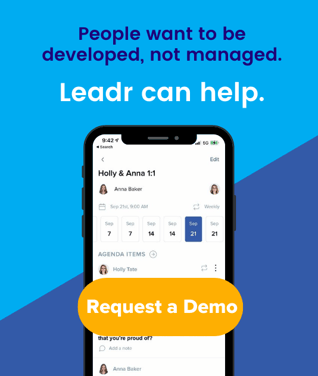5 Steps To Delivering More Effective Feedback
Creating a strong culture of trust on your team is critical to growth, but cultivating that trust is hard. Giving and receiving feedback on a regular basis is one of the best ways to create opportunities for growth and to build trust on your team.
A Forbes article shares that 65% of employees would like more feedback than they currently get. This tells us that creating a culture of feedback is not something we as leaders can afford to put off any longer.
Then why is it so hard to implement? Whether the excuse is lack of time, fear of engaging in difficult conversations, or uncertainty of how to offer feedback, it can often get pushed to the back burner.
It can seem like an intimidating task to learn the “how” of giving feedback and find a solid medium between the two extremes, but it doesn’t have to be! We broke down the process into 5 easy steps - here’s how to do it:
1. Make it a SMART one-on-one:
We think it’s a smart process to start with the one-on-one because this goal-setting acronym can apply to feedback too. Offer your team weekly time to sit down with you where you focus on their growth. Give them feedback that is specific, timely, and incorporates suggestions - nothing is worse than a vague “I don’t like this,” as your employee heads back to their desk, bewildered about what they should do to fix the problem, and only knowing you didn't like it.
Be sure that the one-on-one is happening at least bi-weekly, which will help you not only practice giving feedback until it feels natural, but it will also allow you to use timely examples - this shift will help you celebrate your team in the moment and course-correct quickly. A great question to ask when something goes wrong (as it is inevitable) is “how can we change what we’re doing for next time?” Giving that kind of feedback as soon as you can help shift the conversation from a negative mindset to a growth mindset.
Using timely examples also helps you track a team member’s progress over time versus it being a one-and-done conversation. Officevibe and Forbes report that “four out of 10 workers are actively disengaged when they get little or no feedback;” 82% of employees appreciate positive and negative feedback.” The more often feedback happens, the more regular it becomes. And even if you have to share something constructive, your team will see your goal is to help them improve, not just call out the negative.
2. Be consistent.
In the same vein, don’t save feedback for only a performance review. Employees should never be caught off guard by information in a performance review. Reviews are intended to look back on the previous year’s process, set goals for the future, and reset on vision and purpose moving forward. Here are some quick tips for shifting your mindset on the performance review:
-
Once a year is way too infrequent to have discussions on performance. People can’t improve without guidance. That goes hand in hand with your culture, too. Your productivity and culture can’t grow without constant feedback.
-
An example of behavior (either wins or losses) won’t be applicable 6 months after they happen. Tell your team members now so they can apply the feedback and experience the growth immediately.
-
When you only give feedback once a year, such as in a performance review, you leave people feeling nervous about being evaluated rather than excited to revisit the goals that will help them and their organization move forward.
3. Ensure feedback is a two-way street.
Lead by example by being good at asking for feedback. Each week, ask your direct reports where they felt supported and where they are struggling. Consider sharing a follow-up email with your team after one-on-ones or all-staff meetings that allow people to share their thoughts. Though it may feel uncomfortable at first, there are a ton of benefits:
-
It shows your team that you are investing in your own personal development. Not only will this inspire them, but it will also build trust. If you give feedback, they know you can also receive it, and it’s a safe space to share.
-
It provides a teachable moment. Opening up the feedback loop gives your team a chance to practice the art of offering constructive feedback, which is a critical component of leadership development. An official growth track towards leadership development is great for some team members, but at the same time, you can find small ways for every person on your team to lead, regardless of if they are heading for a managerial position or not.
-
It demonstrates and guides your team in getting better at receiving feedback. It’s not always the easiest thing to hear, but if it’s done with clarity and consistency, it will be an experience that shifts their thinking about feedback overall, which contributes to better growth for everyone.
4. Allow personality insights to guide your discussion.
Personality assessments are a fantastic tool you can use to evaluate whether someone is in the “right seat on the bus,” and doing the right job for them at the company, if they are ready for potential leadership, and understand how to improve and optimize communication and work styles so each person feels valued and heard. Here’s an eye-opening statistic from Hubspot: “69% of employees say they would work harder if they felt their efforts were being better recognized.” A great place to start is getting to know who they are and how they work!
Gallup Workplace points out that great managers take the time to build and guide a conversation around an employee’s unique strengths, so the conversation is naturally positive and constructive. They note this is “the power of individualized conversations. An employee feels known, understood, heard and appreciated -- even when the topic of discussion isn't pleasant.” But without the vital data about their communication style or personality traits - especially in a work context - it can be hard to know where to start.
Here are a few ways that personality assessments can help you deliver more effective feedback:
-
You’ll better understand how people best receive feedback. Are you talking with someone who enjoys more direct communication, is this person data-driven, emotionally motivated? Use that to get the most impact out of your conversations.
-
Developing people begins with knowing their strengths. As you’re considering where to help develop a team member, look at their personality insights to better see where they might enjoy a new stretch project or why they may be struggling in a certain area.
Remember that you hired your team for a reason - maybe a team member has a passion, a gift, or a skill that shines in certain situations. When giving feedback, remember how the two are tied together and that each team member can grow and flourish with the right development. It’s worth the investment to truly get to know them to help them with feedback that makes sense to them.
5. Check your intentions.
If you’re going into a feedback conversation with the goal of growing and strengthening your team members, good. Too often, development is replaced by the idea that, as leaders, it’s our job to get our team to our idea of success. Rather, the goal is to understand where each person on our team wants to develop and help them achieve those goals. Some people are looking to become CEOs and some are happier without ever managing others. These two goals require very different coaching from you as a leader.
Always approach feedback from the lens of growing the right habits, not tearing down the wrong ones. It’s critical that you’re focused on coaching people versus projects. Otherwise, you’ll border on micromanaging territory.
Better Feedback Begins With One-on-One Meetings
Feedback can be a tricky skill to build, but as with any human-oriented task - remember that it’s about relationships and development. As you apply these steps, your team will recognize that you are approaching them with the goal of helping them improve - or acknowledging what they’ve done well.
As trust grows, your team will feel more comfortable coming to you with concerns or wins, and will learn to work with you in recognizing when they’ve gotten off track or when they need to keep going in the right direction. That’s self-aware leadership. And it makes for a great step towards better work within your organization.
Ready to take the first step? We can’t wait to hear how it goes. Share in the comments one way you’ve seen these tips improve communication and feedback with your team. At Leadr, the one-on-one is the heart of what we do. Request a demo to see how our software can elevate and streamline your meetings for improved employee engagement and performance.
Share this
You May Also Like
These Related Stories

5 Ways To Cultivate A Feedback Culture

7 Tips For Giving Negative Feedback








Comments (1)